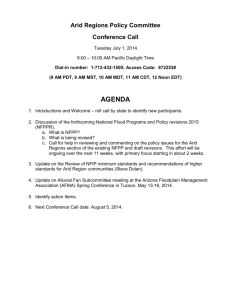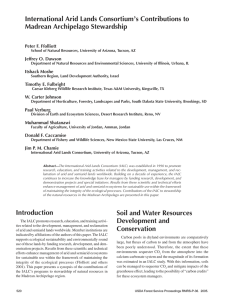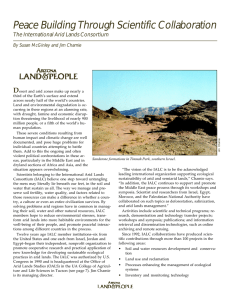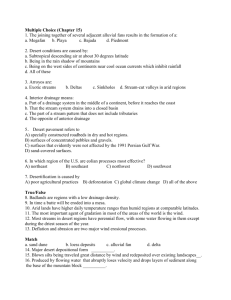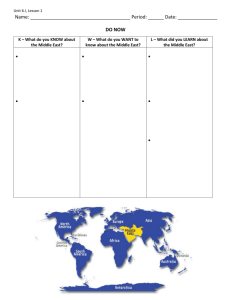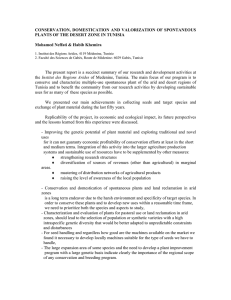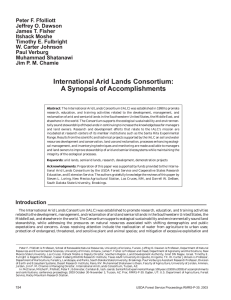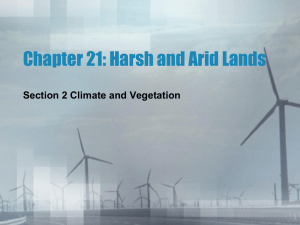International Arid Lands Consortium: Peter F. Ffolliott , James T. Fisher
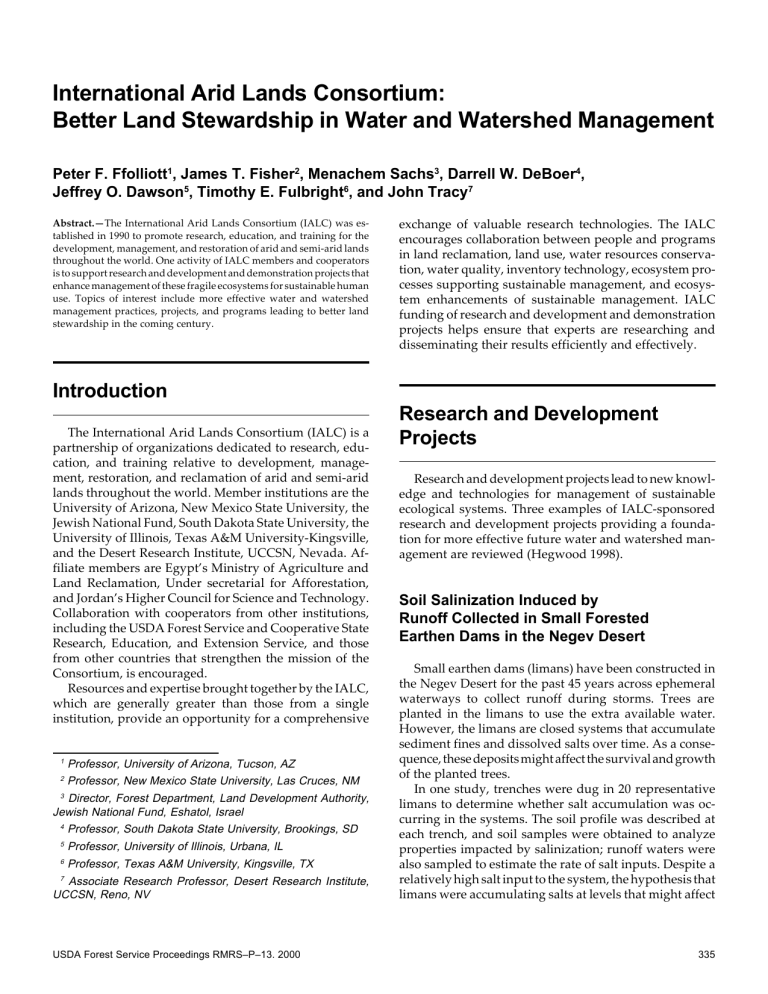
International Arid Lands Consortium:
Better Land Stewardship in Water and Watershed Management
Peter F. Ffolliott
1
, James T. Fisher
2
, Menachem Sachs
3
, Darrell W. DeBoer
4
,
Jeffrey O. Dawson
5
, Timothy E. Fulbright
6
, and John Tracy
7
Abstract.— The International Arid Lands Consortium (IALC) was established in 1990 to promote research, education, and training for the development, management, and restoration of arid and semi-arid lands throughout the world. One activity of IALC members and cooperators is to support research and development and demonstration projects that enhance management of these fragile ecosystems for sustainable human use. Topics of interest include more effective water and watershed management practices, projects, and programs leading to better land stewardship in the coming century.
exchange of valuable research technologies. The IALC encourages collaboration between people and programs in land reclamation, land use, water resources conservation, water quality, inventory technology, ecosystem processes supporting sustainable management, and ecosystem enhancements of sustainable management. IALC funding of research and development and demonstration projects helps ensure that experts are researching and disseminating their results efficiently and effectively.
Introduction
The International Arid Lands Consortium (IALC) is a partnership of organizations dedicated to research, education, and training relative to development, management, restoration, and reclamation of arid and semi-arid lands throughout the world. Member institutions are the
University of Arizona, New Mexico State University, the
Jewish National Fund, South Dakota State University, the
University of Illinois, Texas A&M University-Kingsville, and the Desert Research Institute, UCCSN, Nevada. Affiliate members are Egypt’s Ministry of Agriculture and
Land Reclamation, Under secretarial for Afforestation, and Jordan’s Higher Council for Science and Technology.
Collaboration with cooperators from other institutions, including the USDA Forest Service and Cooperative State
Research, Education, and Extension Service, and those from other countries that strengthen the mission of the
Consortium, is encouraged.
Resources and expertise brought together by the IALC, which are generally greater than those from a single institution, provide an opportunity for a comprehensive
1 Professor, University of Arizona, Tucson, AZ
2 Professor, New Mexico State University, Las Cruces, NM
3 Director, Forest Department, Land Development Authority,
Jewish National Fund, Eshatol, Israel
4 Professor, South Dakota State University, Brookings, SD
5 Professor, University of Illinois, Urbana, IL
6 Professor, Texas A&M University, Kingsville, TX
7 Associate Research Professor, Desert Research Institute,
UCCSN, Reno, NV
Research and Development
Projects
Research and development projects lead to new knowledge and technologies for management of sustainable ecological systems. Three examples of IALC-sponsored research and development projects providing a foundation for more effective future water and watershed management are reviewed (Hegwood 1998).
Soil Salinization Induced by
Runoff Collected in Small Forested
Earthen Dams in the Negev Desert
Small earthen dams (limans) have been constructed in the Negev Desert for the past 45 years across ephemeral waterways to collect runoff during storms. Trees are planted in the limans to use the extra available water.
However, the limans are closed systems that accumulate sediment fines and dissolved salts over time. As a consequence, these deposits might affect the survival and growth of the planted trees.
In one study, trenches were dug in 20 representative limans to determine whether salt accumulation was occurring in the systems. The soil profile was described at each trench, and soil samples were obtained to analyze properties impacted by salinization; runoff waters were also sampled to estimate the rate of salt inputs. Despite a relatively high salt input to the system, the hypothesis that limans were accumulating salts at levels that might affect
USDA Forest Service Proceedings RMRS–P–13. 2000 335
tree survival and growth was not supported by this study.
Soil to a depth of 3 m was non-saline, and salinity inside the limans was lower than in the control trenches. Apparently, afforestation efforts at this low level of technology will prove successful beyond the establishment phase.
simulate changing water quality constituents associated with alternative management schemes and physical site configurations. Intensively monitored wetland and riparian ecosystems in the southwestern United States and
Israel are being studied to test the newly developed decision support system for operational applications.
Water Use by Tree and Shrub forms of
Dryland Oaks
Conservation and sustainable use of oak woodlands in the southwestern United States and Israel require more complete knowledge of their ecological processes. Water use is critical, and affects all components of the ecosystems in these dryland environments. Understanding oak physiology is critical to understanding ecosystem dynamics.
Transpiration by oak trees was estimated by sap velocities measured by the heat-pulse method by researchers in both the U.S. and Israel. Individual tree measurements showed that seasonal trends of water use were related to diameter, height, and crown volume, and to precipitation patterns. Measurements from clusters of trees on undisturbed sites were compared to measurements on sites where trees had been previously harvested. Extrapolated to stand-use values, results indicated that annual water use by oak was about 45% of the annual precipitation on the undisturbed sites, while water use by oak on the harvested sites was nearly 70% of the precipitation. Vigorous sprouting from residual stumps was the attributing factor for this difference. Apparently, harvesting trees has the potential to significantly affect water budgets in oak woodlands.
Decision Support System for Wetland and
Riparian Ecosystems
Wetland and riparian ecosystems must be protected from damage and, when necessary, restored to a desired previous condition. A methodology for examining the impacts of alternative management and design recommendations to protect or restore these fragile environments is being incorporated into a decision support system. This system will optimize a range of environmental, water resource, and economic benefits at a specific site.
This ongoing IALC-supported research and development project is modifying spatially-distributed hydrologic-hydraulics model, and combining the modified model with a geographic information system to account for site spatial variability. A surface-water quality module is also being linked to the hydrologic-hydraulics model to
Demonstration Projects
IALC-supported demonstration projects for management of sustainable ecological systems represent practical applications of the available knowledge and technologies from research and development efforts. Conditions that demonstration projects must meet to be supported by the
IALC have been outlined elsewhere by Ffolliott et al.
(1998). Three examples of IALC-sponsored demonstration projects contributing to more effective water and watershed management are reviewed (Hegwood 1998).
International Workshop on Arid Lands
Management
This workshop, held in Israel in 1994, established a state-of-knowledge on the functioning of arid and semiarid land ecosystems and their management. This information has been used to ask the IALC, and other granting institutions that support research related to the ecological sustainability in these systems, to describe the state-ofknowledge and determine where to best allocate resources to increase the available information about arid and semiarid ecology and management. Another use of this stateof-knowledge has been to distribute it to planners and managers, and other granting institutions with related programs, to incorporate this into their management programs.
The established state-of-knowledge published in the book Arid Lands Management: Towards Ecological Sustainability,” is a reference for policy-makers, representatives of legislative bodies, planners, researchers, managers, and lay people interested in arid and semi-arid regions where effective water and watershed management is a priority concern. This publication is comprised of chapters on the ecological framework for conservation and sustainability; ecosystems of the desert and their management; land use and management in selected desert ecosystems of the world; and planning, simulation, and operations research approaches to arid and semi-arid lands management (Hoekstra and Shachak 1999).
336 USDA Forest Service Proceedings RMRS–P–13. 2000
Savannization in the Negev Desert
The objective of savannization, initiated by the Land
Development Authority in 1986, has been to increase biological productivity and diversity of land-use in the degraded Negev Desert of Israel; and develop land management practices for sustained, ecologically-sound use of desert ecosystems. Savannization techniques focus on creating patches of relatively high productivity by planting trees in desert landscapes of lower productivity. These patches benefit from soil-water enhancement through collection of surface runoff from undisturbed adjacent areas by applying water harvesting techniques. Only small portions of effected landscapes are altered to create enriched patches within the poorer surrounding matrix.
Savannization increases fiber and fuel production, improves rangeland quality, enhances recreational assets, and increases dust control. Greater biological diversity and biomass productivity than on over-exploited desert landscapes result. This IALC-sponsored demonstration project synthesizes models to foster efficient methods of managing desert landscapes, enhancing their limited productivity, increasing and sustaining their use, and combating desertification.
Multi-media Demonstrations of
IALC-Supported Research
Results
This technology-transfer project illustrates the effectiveness of IALC-supported research through print, video, and World Wide Web media. Target audiences include policy-makers, supporters of arid lands research and development, and stakeholders in the sustainable development of arid land resources. These audiences typically have limited time for extensive evaluations of research findings and might not fully understand the complexities or values of arid land resources. An important tool to help change misconceptions and alter social action and political policy is to present key concepts about management of arid and semi-arid land ecosystems to provide sustainable benefits with minimal environmental degradation; this is largely the objective of this project.
Transfer of Management Information on
Semi-Arid Watersheds
Watershed management involves manipulation of natural, agricultural, and human resources to achieve specified objectives, while considering the social, economic, and institutional factors operating within a river basin or other relevant region. Usefulness of watershed management practices to increase multiple-resource benefits has been, and continues to be, an interest of the IALC, USDA
Forest Service, and other land management agencies and their cooperators.
Literature on watershed management practices in semiarid regions has been scattered and, therefore, not readily accessible. Therefore, a three-pronged approach has been initiated to deliver this information to an audience broader than management professionals. This IALC-sponsored demonstration project is bringing this information to the public through the World Wide Web and other technology-delivery systems. Additionally, a telephone system provides people with recorded messages on the benefits of watershed management. Field days, held to introduce the concepts of integrated, multiple-use oriented watershed management to the public, allow participants to experience “hands on” demonstrations, conduct limited experiments, and perform watershed management monitoring techniques.
Summary
The IALC works to achieve research and development and demonstration projects, educational and training initiatives, workshops, and technology-transfer activities about the development, management, restoration, and reclamation of arid and semi-arid lands worldwide. All of these activities are supported by the IALC’s member institutions through efforts aimed at sustaining arid and semi-arid land ecological systems and human populations inhabiting these systems. Included among these activities are efforts directed toward effective water and watershed management practices, projects, and programs to address land stewardship issues and constraints in the coming century.
Acknowledgments
The authors, members of the Research and Demonstration Advisory Committee of the IALC, wish to thank
Donald A. Hegwood and Jim P. M. Chamie, Executive
Vice President and Managing Director of the IALC, respectively, for their technical reviews of this paper.
USDA Forest Service Proceedings RMRS–P–13. 2000 337
Literature Cited
Ffolliott, P. F., J. T. Fisher, Menachem Sachs, D. W. DeBoers,
J. O. Dawson, and T. E. Fulbright. 1998. Role of demonstration projects in combating desertification. Journal of Arid Environments 39:155-163.
Hegwood, D. A., editor. 1998. International Arid Lands
Consortium: A compendium of funded projects. International Arid Lands Consortium, Tucson, Arizona.
Hoekstra, T. W., and M. Shachak, editors. 1999. Arid lands management: Towards ecological sustainability. University of Illinois Press, Urbana, Illinois.
338 USDA Forest Service Proceedings RMRS–P–13. 2000

